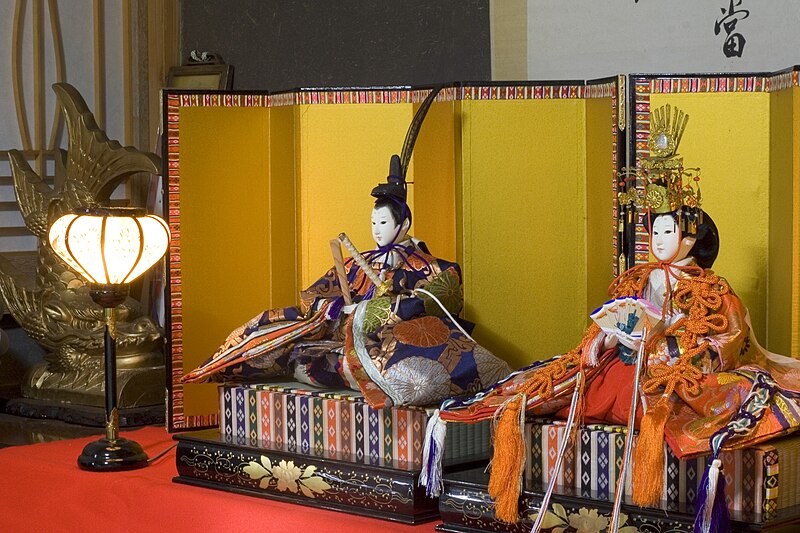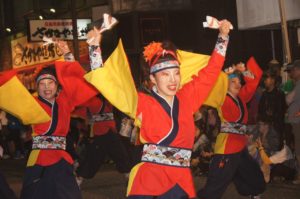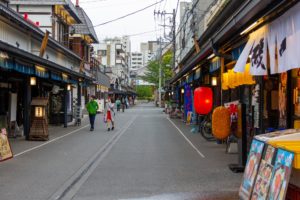Hinamatsuri: Japan’s Beloved Doll Festival or Girls’ Day
Every year on March 3rd, Japanese people celebrate 雛祭り Hinamatsuri (the Doll Festival), also known as 女の子の祭り On’nanoko no matsuri (Girls’ Day). This special day celebrates the health, happiness, and prosperity of young girls. Families across Japan honor the occasion with intricate doll displays, traditional foods, and heartfelt wishes for their daughters’ bright futures. In this post we’ll take a quick look at the origins and customs of this holiday.
The History and Origins of Hinamatsuri: Japan’s Doll Festival
Hinamatsuri, Japan’s Doll Festival or Girls’ Day, dates back over a thousand years to the 平安時代 Heian jidai (Heian Period), from 794 to 1185. It evolved from an ancient ritual called ひな流し hina-nagashi, where people floated paper dolls down rivers to carry away bad luck and misfortune. Over time, the practice transformed into the more decorative and celebratory event we know today. By the 江戸時代 Edo jidai (Edo Period), from 1603 to 1868, the custom of displaying ornamental dolls became widespread among noble and samurai families. This eventually trickled down to common households.
Today’s Celebrations of Hinamatsuri: Japan’s Doll Festival
The most iconic feature of Girls’ Day is the elegant, tiered doll display 雀殿 hina-dan displaying 雛人形 hina-ningyō (ornamental dolls). These platforms, typically covered in a bright red cloth, showcase beautifully dressed dolls representing the imperial court. The top tier holds the 男雛 obina (male doll) and 女雛 mebina (female doll) of a Heian period wedding. These dolls are also known as the お円様 Odairi-sama (Emporer) andお雀様 Ohina-sama(Empress). Lower tiers display court ladies, musicians, ministers, and miniature accessories such as furniture and food.
Families begin setting up these displays in mid-February, and take them down promptly after March 3rd. According to superstition, leaving the dolls out too long may delay a daughter’s good fortune.
Aside from doll displays, many households and schools host gatherings where children dress in beautiful kimono and participate in traditional activities. In some regions, hina-nagashi is still practiced, with dolls being set afloat in boats on rivers as a symbolic gesture to ward off misfortune. The dolls and boats are then collected and ritually burned at a shrine, instead of becoming ocean borne pollution.
Special Foods for Girls’ Day
No Japanese festival is complete without special foods, and Girls’ Day is no exception! Here are some traditional treats associated with Hinamatsuri, Japan’s Doll Festival.
- ひなあられ hinaarare: Crispy, colorful rice crackers symbolizing health and good fortune.
- ちらし寿司chirashizushi: A festive sushi rice bowl dish featuring vinegared rice topped with ingredients like shrimp, lotus root, egg, and vegetables.
- はまぐりのお吸い物hamaguri no osuimono: A clear clam soup, symbolizing a happy marriage since clam shells fit together perfectly.
- 菱餅hishimochi: A three-layer rice cake with a pink layer, a white layer, and a green layer.
- 白酒shirozake: A sweet, non-alcoholic fermented rice drink traditionally enjoyed during the celebration.
The Cultural Significance of Hinamatsuri
Hinamatsuri, Japan’s Doll Festival or Girls’ Day, is more than just a visually stunning festival; it reflects deep cultural values. The emphasis on family, tradition, and wishes for a child’s happiness highlights the importance of love and protection. It also showcases Japan’s appreciation for craftsmanship, as many 雛人形 hina-ningyōare meticulously handcrafted heirlooms passed down through generations.
While Hinamatsuri is primarily celebrated by families with daughters, the festival holds broader significance as a reminder to cherish and support the younger generation. It remains a beloved tradition that connects the past with the present, ensuring that Japan’s cultural heritage continues to flourish. お祭りを楽しんでね! Omatsuri o tanoshinde ne! Enjoy the Festival! ひなまつり、おめでとう!Hinamatsuri omedetō! Happy Hinamatsuri!
Get on the road to speaking Japanese with the Language Garage!
We hope you’ve enjoyed learning about Hinamatsuri, Japan’s Doll Festival, also known as Girls’ Day. If you’d like to learn more:
- Follow us on Facebook, LinkedIn, BlueSky, Twitter, Threads, Instagram, or Pinterest. We publish lots of Japanese vocabulary, grammar, and culture notes, so it’s a great way to pick up some new vocabulary and practice.
- Check out our other posts on Japanese language, culture, and more.
- Enroll in affordable, flexible, and personalized private online Japanese lessons or sign up for a small group online Japanese class.
- Create a free Language Garage account to access tons of Japanese vocabulary, grammar, and culture.
Image Source Wikimedia Commons






